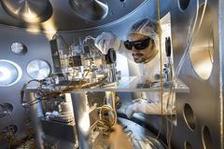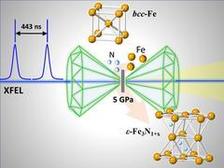View into the experimental chamber at the High Energy Density Instrument of the European XFEL (Credit: European XFEL).
An international group of researchers including from DESY has pioneered a new way of performing static high-pressure and high-temperature experiments, using so-called diamond-anvil cells at the X-ray laser European XFEL, and discovered a new, faster route to produce iron nitrides, promising candidates for high-density data storage and other applications. The scientists report their results in two publications.
Nitrides are compounds of nitrogen (N) and other elements. Nitrides of transition metals like iron (Fe) are an important group of industrially relevant materials because of their versatile magnetic, electrical and mechanical properties. “In particular iron nitrides have gained the interest of industry because of possible applications as high-density magnetic recording media as well as for use in catalysis and as high wear-resistant and corrosion-resistant material,” says Yongjae Lee from Yonsei University in South Korea. A team led by Lee has now found the new, extremely fast way to synthesise iron nitrides, as the scientists report in the Journal of Physical Chemistry Letters.
In their work, the researchers followed the reaction of an iron foil with nitrogen under X-ray bombardment at 50,000 times atmospheric pressure in diamond-anvil cells (DACs) – which use ultra-strong diamonds to squeeze matter during the experiments.
The reaction between the iron foil and the nitrogen was initiated by a series of ultra-bright X-ray pulses from the European XFEL. “The X-ray pulses can be used both to initiate and probe the chemical reaction,” explains lead author Huijeong Hwang. “We estimate that sample temperatures up to 5400 degrees Celsius were reached by varying the power and the repetition rate of the incident X-ray pulses.” Under the right pulse conditions, a chemical reaction between iron and nitrogen was initiated and the formation of the iron nitride designated ε-Fe3N1.33 was observed.
“The product, homogeneous iron nitride, took only hundreds of nanoseconds to form which is highly unusual,“ says co-author and high-pressure physics specialist Hanns-Peter Liermann from DESY. „Normally, atomic nitrogen diffuses into solid iron at reaction times of hundreds of seconds to form iron nitride layers, and in heated diamond anvil cells di-iron nitride Fe2N was formed at similar timescales.” A nanosecond is a billionth of a second. So, the new path is roughly a billion times faster.
“One pulse contains about a hundred billion photons and the cumulative energy over all the pulses reaching the sample and initiating the reaction amounted to about three millijoule,” calculates Liermann. The team has shown that intense X-ray laser pulses can be used to provide the necessary energy to initiate distinctive chemical reactions and be used in ‘pump-probe’ experiments to follow the evolution of reactions of solids surrounded by volatile media in high-pressure environments.
“Systematic exploration of chemical reactivity across a broad range of reactants with contrasting atomic numbers at extreme pressures and temperatures is expected to lead to the discovery of hitherto unknown pathways not only to industrially relevant compounds, but also to compounds that are needed to understand the chemistry of astrophysical objects and processes, for instance,” explains co-author Valerio Cerantola, local contact for the experiment and Instrument Scientist at European XFEL's HED group.
The experiment is only one of a series of new static high-pressure experiments that an international group of more than 40 scientists from 22 institutions performed at the European XFEL, led by Stewart McWilliams from the University of Edinburgh. While performing these experiments, the team commissioned the new static high-pressure diamond anvil cell setup designed by the Helmholtz International Beamline for Extreme Fields (HIBEF) consortium for the High Energy Density (HED) instrument at European XFEL to create and study these extreme pressure and temperature conditions exploiting the unprecedented X-ray pulse time resolution of the European XFEL. The group describes the concepts for performing research with this novel experimental setup in the Journal of Synchrotron Radiation.
DESY is one of the founding institutions of the HIBEF consortium which is led by Helmholtz-Zentrum Dresden-Rossendorf (HZDR). The European XFEL X-ray laser in the Hamburg metropolitan region is an international research facility, powered by the world's largest linear particle accelerator, starting at DESY. DESY is the main shareholder of the European XFEL non-profit company. At present, 12 countries have signed the European XFEL convention: Denmark, France, Germany, Hungary, Italy, Poland, Russia, Slovakia, Spain, Sweden, Switzerland, and the United Kingdom.
(from DESY News)
References:
X‐ray Free Electron Laser-Induced Synthesis of ε‐Iron Nitride at High Pressures; Huijeong Hwang et al.; „Journal of Physical Chemistry Letters“, 2021; DOI: 10.1021/acs.jpclett.1c00150
Novel experimental setup for megahertz X-ray diffraction in a diamond anvil cell at the High Energy Density (HED) instrument of the European X-ray Free-Electron Laser (EuXFEL); Hanns-Peter Liermann et al.; „Journal of Synchrotron Radiation“, 2021; DOI: 10.1107/S1600577521002551








